The Lunar Regolith Structure and Electromagnetic Properties of Chang’E-5 Landing Site
Abstract
:1. Introduction
2. LRPR Equipment and Data Acquisition
2.1. Equipment
2.2. Work Process
3. Processing Methods
3.1. Data Preprocessing
- (a)
- Remove DC
- (b)
- Correct channel delay
- (c)
- Remove background clutter
3.2. Height Calculation
3.3. EM Properties Estimation
- (a)
- RCS for smooth surface, ;
- (b)
- RCS for the rough surface, ;
- (c)
- RCS for discrete spherical objects, .
3.4. Migration Imaging
4. Results and Discussion
4.1. The Imaging Results and Shallow Lunar Regolith Structure
4.2. The Relative Dielectric Constant
4.3. Attenuation Characteristics of Lunar Regolith
5. Conclusions
- For the first time, the hyperfine structure of shallow lunar regolith is obtained with a depth of 3 m, and the lunar regolith thickness of the CE-5 landing site is beyond 3 m.
- Ground penetrating radar should be used to detect the drill sampling area in advance, which can effectively prevent the potential hazards in the process of drilling and sampling.
- The relative dielectric constant of the surface lunar regolith of the CE-5 landing area is 2.520 ± 0.186, which is slightly higher than the CE-4 landing site of 2.35 ± 0.20 and slightly lower than the CE-3 landing site of 2.89, consistent with the size and distribution of exposed lunar rocks in the landing site. The bulk density of the surface lunar regolith of the CE-5 landing site is about 1.418 ± 0.186 g/cm3.
- The loss tangent is about 0.0133 ± 0.0020 of the CE-5 landing site when the center frequency is 873.6 MHz. The attenuation is similar to that of the CE-3 landing site, which is greater than that of the CE-4 landing site. The FeO+TiO2 content of the CE-5 landing site is about 24.76 ± 1.85 wt. %.
Author Contributions
Funding
Institutional Review Board Statement
Informed Consent Statement
Data Availability Statement
Acknowledgments
Conflicts of Interest
References
- Ming, D. Lunar sourcebook. A User’s Guide to the Moon; Cambridge University Press: Cambridge, UK, 1992; Volume 16. [Google Scholar] [CrossRef]
- Nozette, S.; Rustan, P.; Pleasance, L.P.; Kordas, J.F.; Lewis, I.T.; Park, H.S.; Priest, R.E.; Horan, D.M.; Regeon, P.; Lichtenberg, C.L.; et al. The Clementine Mission to the Moon: Scientific Overview. Science 1994, 266, 1835–1839. [Google Scholar] [CrossRef] [PubMed]
- Chin, G.; Brylow, S.; Foote, M.; Garvin, J.; Kasper, J.; Keller, J.; Litvak, M.; Mitrofanov, I.; Paige, D.; Raney, K.; et al. Lunar Reconnaissance Orbiter Overview: The Instrument Suite and Mission. Space Sci. Rev. 2007, 129, 391–419. [Google Scholar] [CrossRef]
- Colaprete, A.; Schultz, P.; Goldstein, D.; Summy, D.; Bart, G.D.; Asphaug, E.; Korycansky, D.; Landis, D.; Sollitt, L.; Heldmann, J.; et al. Detection of Water in the LCROSS Ejecta Plume. Science 2010, 330, 463–468. [Google Scholar] [CrossRef] [PubMed]
- Ziyuan, O. Science Results of Chang’e-1 Lunar Orbiter and Mission Goals of Chang’e-2, Spacecraft Engineering. 2010. Available online: https://en.cnki.com.cn/Article_en/CJFDTOTAL-HTGC201005003.htm (accessed on 28 July 2022).
- Li, C.; Su, Y.; Pettinelli, E.; Xing, S.; Ding, C.; Liu, J.; Ren, X.; Lauro, S.E.; Soldovieri, F.; Zeng, X.; et al. The Moon’s farside shallow subsurface structure unveiled by Chang’E-4 Lunar Penetrating Radar. Sci. Adv. 2020, 6, eaay6898. [Google Scholar] [CrossRef]
- Xiao, L.; Zhu, P.; Fang, G.; Xiao, Z.; Zou, Y.; Zhao, J.; Zhao, N.; Yuan, Y.; Qiao, L.; Zhang, X.; et al. A young multilayered terrane of the northern Mare Imbrium revealed by Chang’E-3 mission. Science 2015, 347, 1226–1229. [Google Scholar] [CrossRef] [PubMed]
- Carrier, W.D., III; Olhoeft, G.R.; Mendell, W. Physical Properties of the Lunar Surface. In Lunar Sourcebook; Heiken, G.H., Vaniman, D.T., French, B.M., Eds.; Cambridge University Press: Cambridge, UK, 1991; pp. 522–530. [Google Scholar]
- Wang, J.; Zhang, Y.; Di, K.; Chen, M.; Duan, J.; Kong, J.; Xie, J.; Liu, Z.; Wan, W.; Rong, Z.; et al. Localization of the Chang’e-5 Lander Using Radio-Tracking and Image-Based Methods. Remote Sens. 2021, 13, 590. [Google Scholar] [CrossRef]
- Li, C.; Hu, H.; Yang, M.-F.; Pei, Z.-Y.; Zhou, Q.; Ren, X.; Liu, B.; Liu, D.; Zeng, X.; Zhang, G.; et al. Characteristics of the lunar samples returned by the Chang’E-5 mission. Natl. Sci. Rev. 2022, 9, nwab188. [Google Scholar] [CrossRef] [PubMed]
- He, Q.; Li, Y.; Baziotis, I.; Qian, Y.; Xiao, L.; Wang, Z.; Zhang, W.; Luo, B.; Neal, C.R.; Day, J.M.; et al. Detailed petrogenesis of the unsampled Oceanus Procellarum: The case of the Chang’e-5 mare basalts. Icarus 2022, 383, 115082. [Google Scholar] [CrossRef]
- Qian, Y.; Xiao, L.; Wang, Q.; Head, J.W.; Yang, R.; Kang, Y.; van der Bogert, C.H.; Hiesinger, H.; Lai, X.; Wang, G.; et al. China’s Chang’e-5 landing site: Geology, stratigraphy, and provenance of materials. Earth Planet. Sci. Lett. 2021, 561, 116855. [Google Scholar] [CrossRef]
- Yue, Z.; Di, K.; Liu, Z.; Michael, G.; Jia, M.; Xin, X.; Liu, B.; Peng, M.; Liu, J. Lunar regolith thickness deduced from concentric craters in the CE-5 landing area. Icarus 2019, 329, 46–54. [Google Scholar] [CrossRef]
- Sato, H.; Robinson, M.S.; Lawrence, S.J.; Denevi, B.W.; Hapke, B.; Jolliff, B.L.; Hiesinger, H. Lunar mare TiO 2 abundances estimated from UV/Vis reflectance. Icarus 2017, 296, 216–238. [Google Scholar] [CrossRef]
- Li, Y.; Lu, W.; Fang, G.; Zhou, B.; Shen, S. Performance verification of Lunar Regolith Penetrating Array Radar of Chang’E-5 mission. Adv. Space Res. 2019, 63, 2267–2278. [Google Scholar] [CrossRef]
- Xiao, Y.; Su, Y.; Dai, S.; Feng, J.; Xing, S.; Ding, C.; Li, C. Ground experiments of Chang’e-5 lunar regolith penetrating radar. Adv. Space Res. 2019, 63, 3404–3419. [Google Scholar] [CrossRef]
- Feng, J.; Su, Y.; Ding, C.; Xing, S.; Dai, S.; Zou, Y. Dielectric properties estimation of the lunar regolith at CE-3 landing site using lunar penetrating radar data. Icarus 2017, 284, 424–430. [Google Scholar] [CrossRef]
- Lai, J.; Xu, Y.; Zhang, X.; Xiao, L.; Yan, Q.; Meng, X.; Zhou, B.; Dong, Z.; Zhao, D. Comparison of Dielectric Properties and Structure of Lunar Regolith at Chang’e-3 and Chang’e-4 Landing Sites Revealed by Ground-Penetrating Radar. Geophys. Res. Lett. 2019, 46, 12783–12793. [Google Scholar] [CrossRef]
- Dong, Z.; Fang, G.; Zhou, B.; Zhao, D.; Gao, Y.; Ji, Y. Properties of Lunar Regolith on the Moon’s Farside Unveiled by Chang’E-4 Lunar Penetrating Radar. J. Geophys. Res. Planets 2021, 126, e2020JE006564. [Google Scholar] [CrossRef]
- Zhang, L.; Xu, Y.; Bugiolacchi, R.; Hu, B.; Liu, C.; Lai, J.; Zeng, Z.; Huo, Z. Rock abundance and evolution of the shallow stratum on Chang’e-4 landing site unveiled by lunar penetrating radar data. Earth Planet. Sci. Lett. 2021, 564, 116912. [Google Scholar] [CrossRef]
- Su, Y.; Wang, R.; Deng, X.; Zhang, Z.; Zhou, J.; Xiao, Z.; Ding, C.; Li, Y.; Dai, S.; Ren, X.; et al. Hyperfine Structure of Regolith Unveiled by Chang’E-5 Lunar Regolith Penetrating Radar. IEEE Trans. Geosci. Remote Sens. 2022, 60, 1–14. [Google Scholar] [CrossRef]
- Lu, W.; Li, Y.; Ji, Y.; Tang, C.; Zhou, B.; Fang, G. Ultra-Wideband MIMO Array for Penetrating Lunar Regolith Structures on the Chang’e-5 Lander. Electronics 2021, 10, 8. [Google Scholar] [CrossRef]
- Shen, S.; Zhou, B.; Li, Y.; Lu, W.; Liu, Q.; Tang, C.; Fang, G.; Wang, L. The Design of Payload Lunar Regolith Penetrating Radar on Chang’E-5 Lander. IEEE Aerosp. Electron. Syst. Mag. 2021, 36, 4–16. [Google Scholar] [CrossRef]
- Li, Y.; Lu, W.; Fang, G.; Shen, S. The Imaging Method and Verification Experiment of Chang’E-5 Lunar Regolith Penetrating Array Radar. IEEE Geosci. Remote Sens. Lett. 2018, 15, 1006–1010. [Google Scholar] [CrossRef]
- Dong, Z.; Fang, G.; Ji, Y.; Gao, Y.; Wu, C.; Zhang, X. Parameters and structure of lunar regolith in Chang’E-3 landing area from lunar penetrating radar (LPR) data. Icarus 2017, 282, 40–46. [Google Scholar] [CrossRef]
- Dorizon, S.; Ciarletti, V.; Plettemeier, D.; Benedix, W. Performance validation of the ExoMars 2018 WISDOM GPR in ice caves, Austria. Planet. Space Sci. 2016, 120, 1–14. [Google Scholar] [CrossRef]
- Grimm, R.E.; Heggy, E.; Clifford, S.; Dinwiddie, C.; McGinnis, R.; Farrell, D. Absorption and scattering in ground-penetrating radar: Analysis of the Bishop Tuff. J. Geophys. Res. Earth Surf. 2006, 111, 1–15. [Google Scholar] [CrossRef]
- Noon, D.A.; Stickley, G.F.; Longstaff, D. A frequency-independent characterisation of GPR penetration and resolution performance. J. Appl. Geophys. 1998, 40, 127–137. [Google Scholar] [CrossRef]
- Feng, J.; Su, Y.; Li, C.; Dai, S.; Xing, S.; Xiao, Y. An imaging method for Chang’e−5 Lunar Regolith Penetrating Radar. Planet. Space Sci. 2019, 167, 9–16. [Google Scholar] [CrossRef]
- Feng, J.; Siegler, M.A.; White, M.N. Shallow Regolith Structure and Obstructions Detected by Lunar Regolith Penetrating Radar at Chang ’ E-5 Drilling Site. Remote Sens. 2022, 14, 3378. [Google Scholar] [CrossRef]
- Zheng, Y.; Yang, M.; Deng, X.; Jin, S.; Peng, J.; Su, Y.; Gu, Z.; Chen, L.; Pang, Y.; Zhang, N. Analysis of Chang’e-5 lunar core drilling process. Chin. J. Aeronaut. 2022. [Google Scholar] [CrossRef]
- Ding, C.; Xiao, Z.; Su, Y.; Zhao, J.; Cui, J. Compositional variations along the route of Chang’e-3 Yutu rover revealed by the lunar penetrating radar. Prog. Earth Planet. Sci. 2020, 7, 1–11. [Google Scholar] [CrossRef]
- Feng, J.; Siegler, M.A.; White, M.N. Dielectric properties and stratigraphy of regolith in the lunar South Pole-Aitken basin: Observations from the Lunar Penetrating Radar. Astron. Astrophys. 2022, 661, A47. [Google Scholar] [CrossRef]
- Olhoeft, G.; Strangway, D. Dielectric properties of the first 100 meters of the Moon. Earth Planet. Sci. Lett. 1975, 24, 394–404. [Google Scholar] [CrossRef]
- Hickson, D.; Boivin, A.; Daly, M.G.; Ghent, R.; Nolan, M.C.; Tait, K.; Cunje, A.; Tsai, C.A. Near surface bulk density estimates of NEAs from radar observations and permittivity measurements of powdered geologic material. Icarus 2018, 306, 16–24. [Google Scholar] [CrossRef]
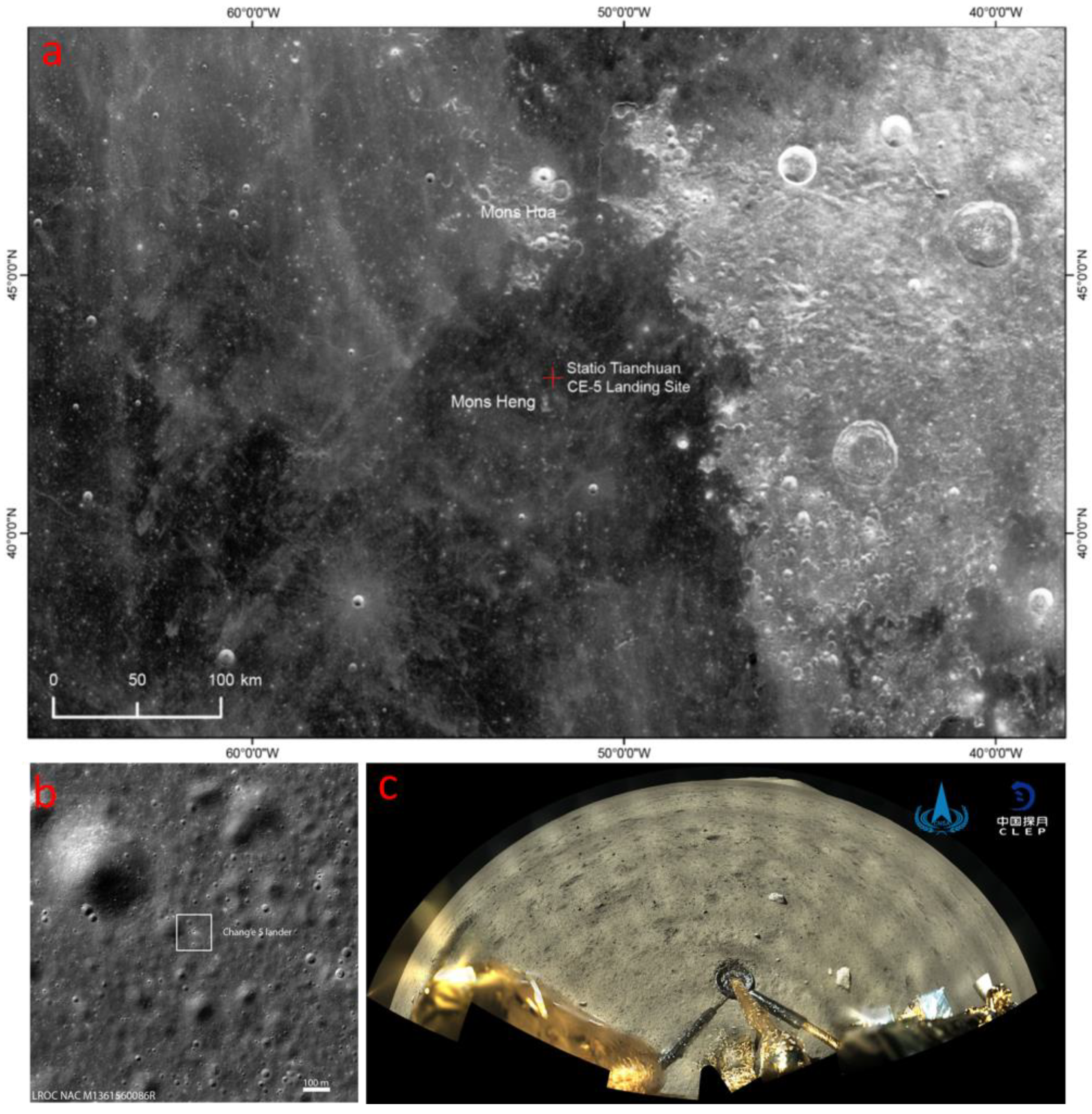
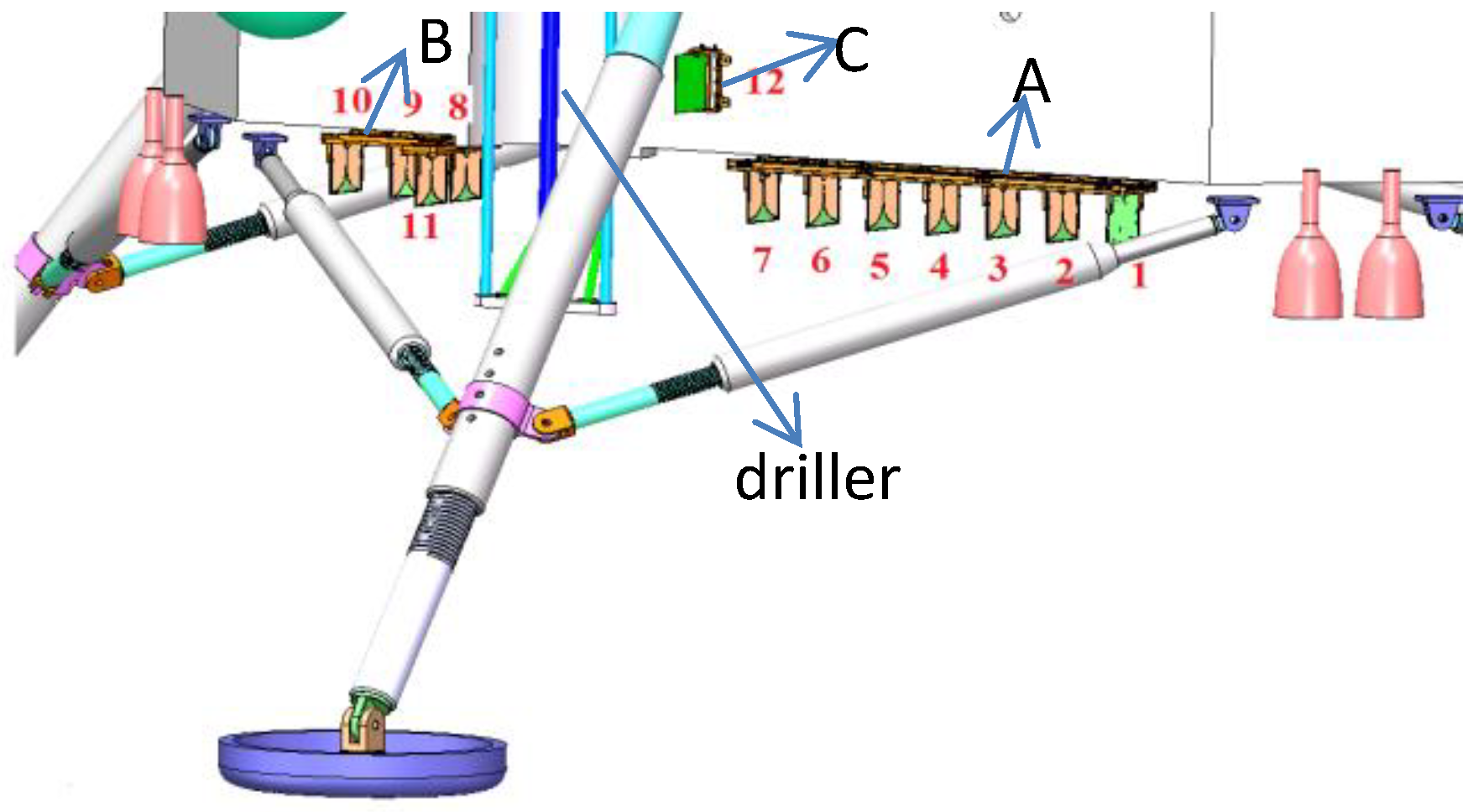
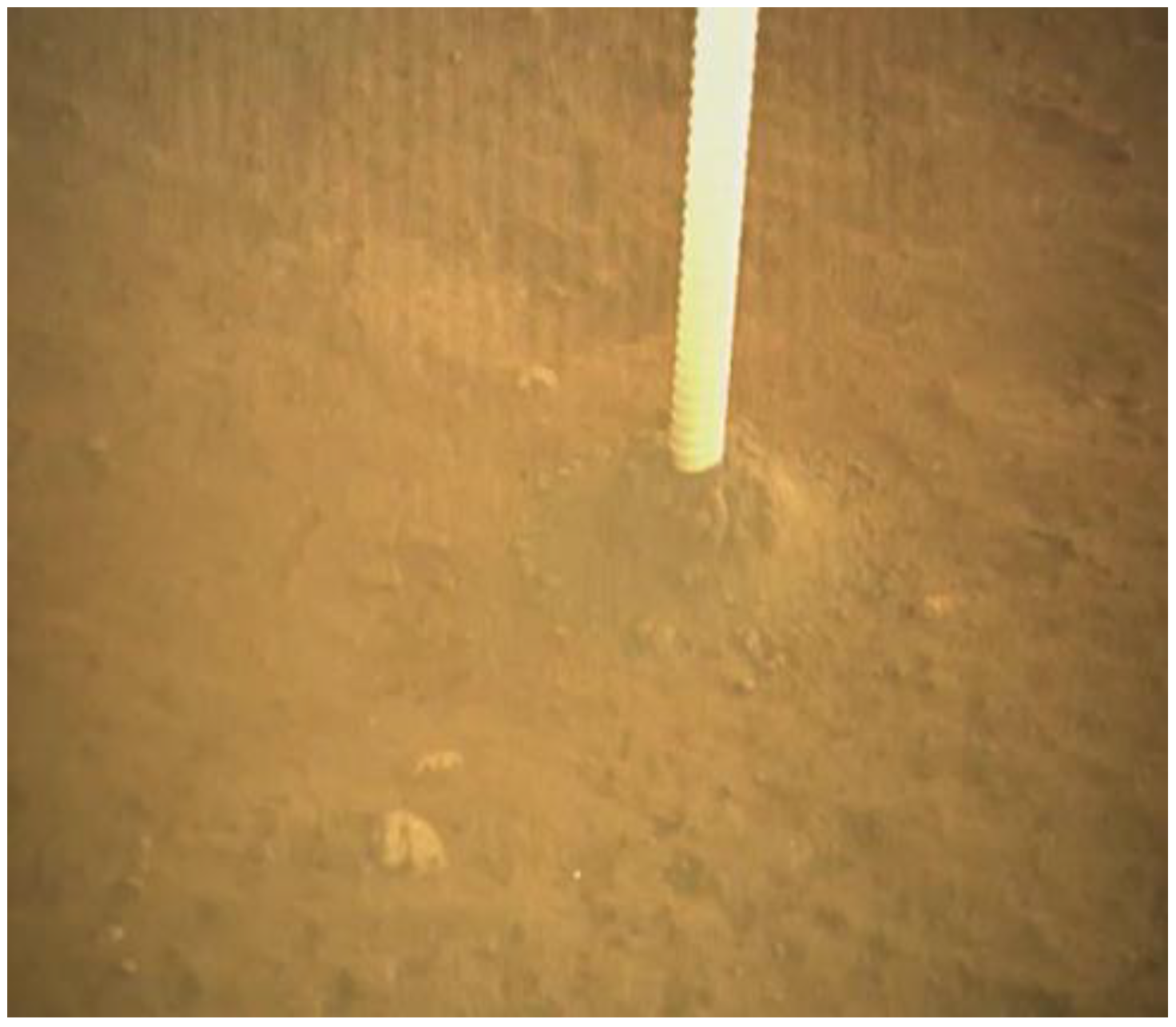

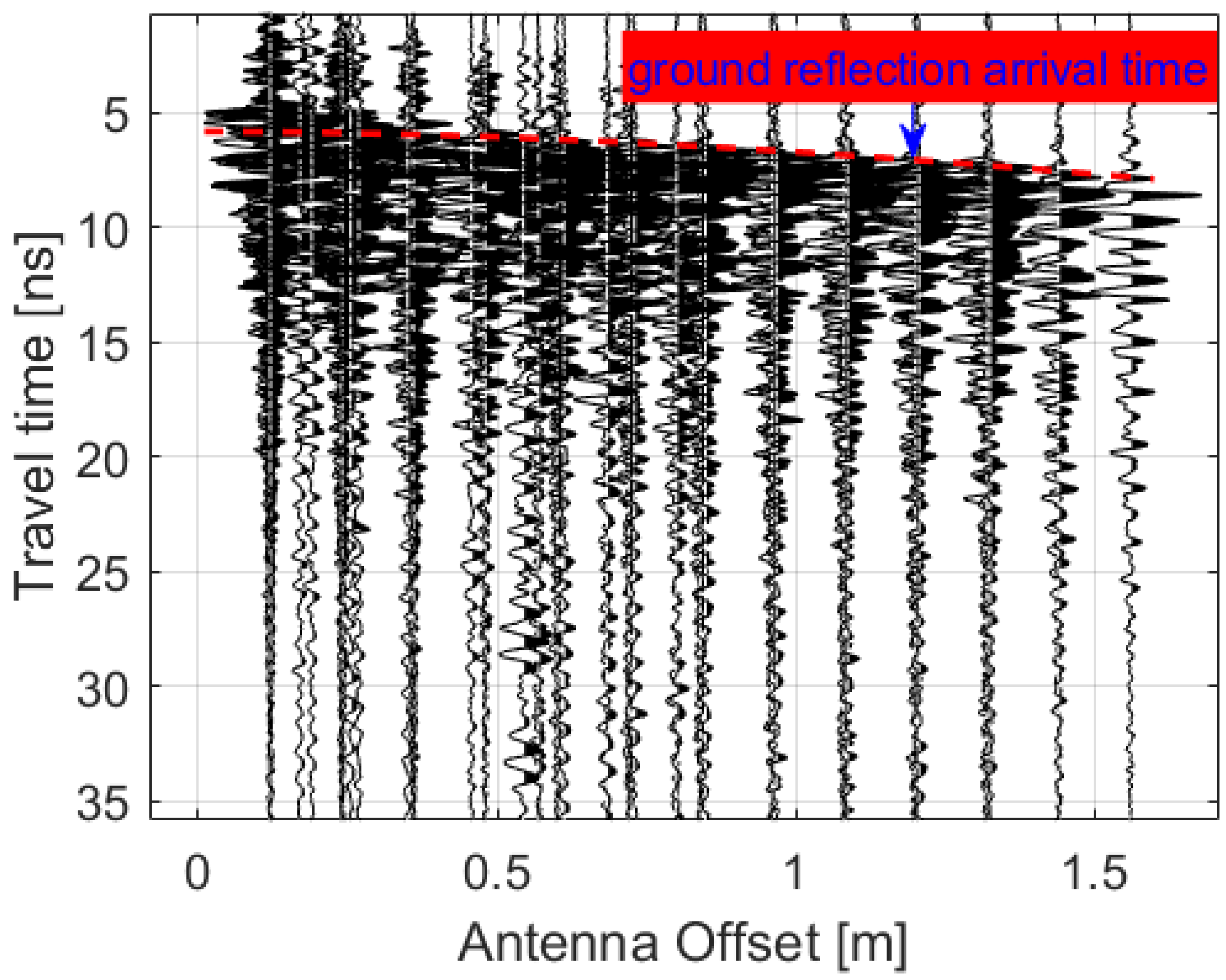

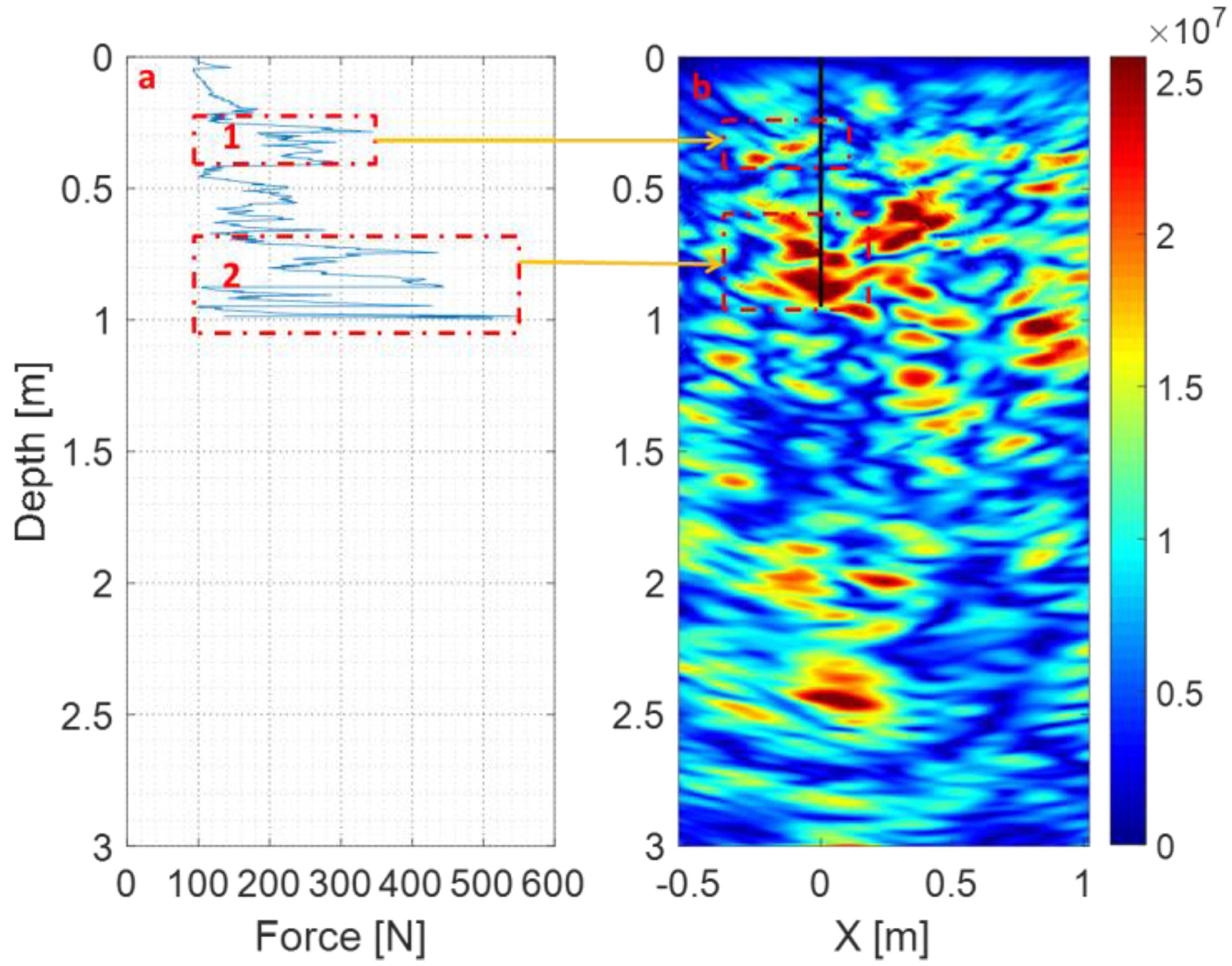
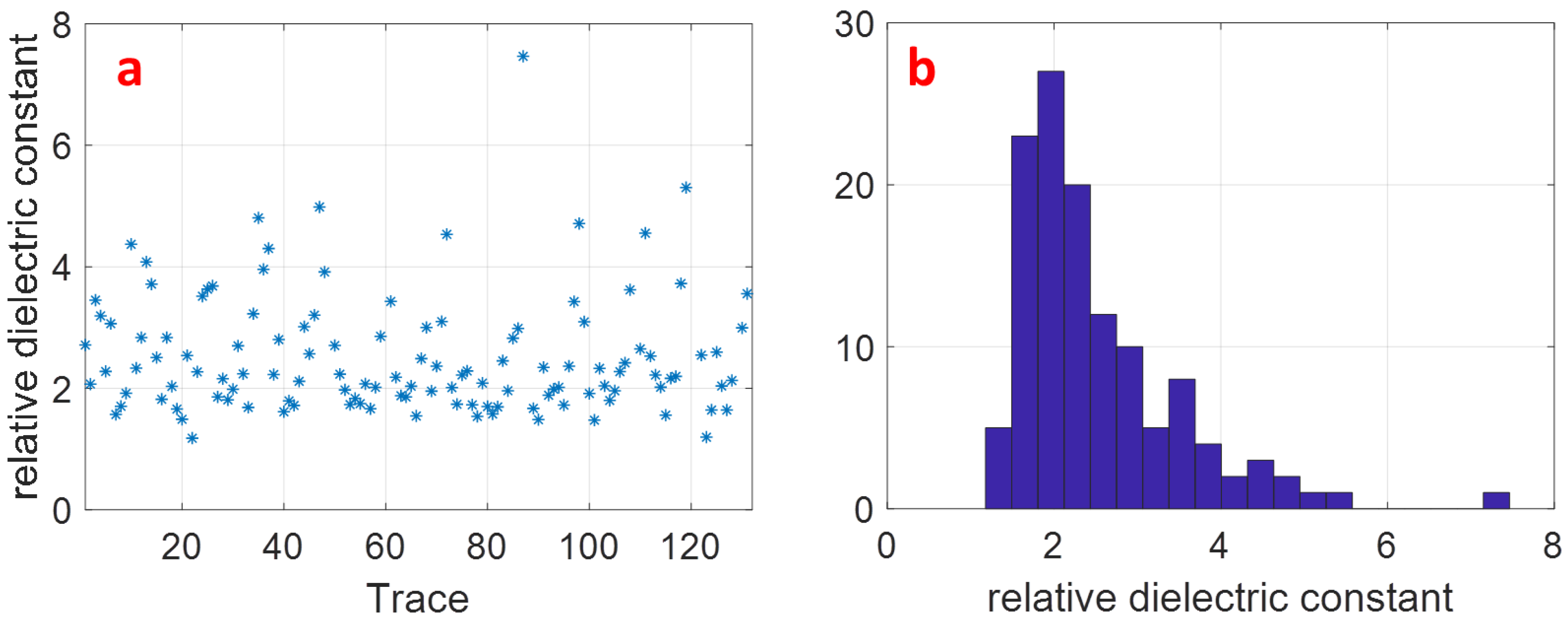
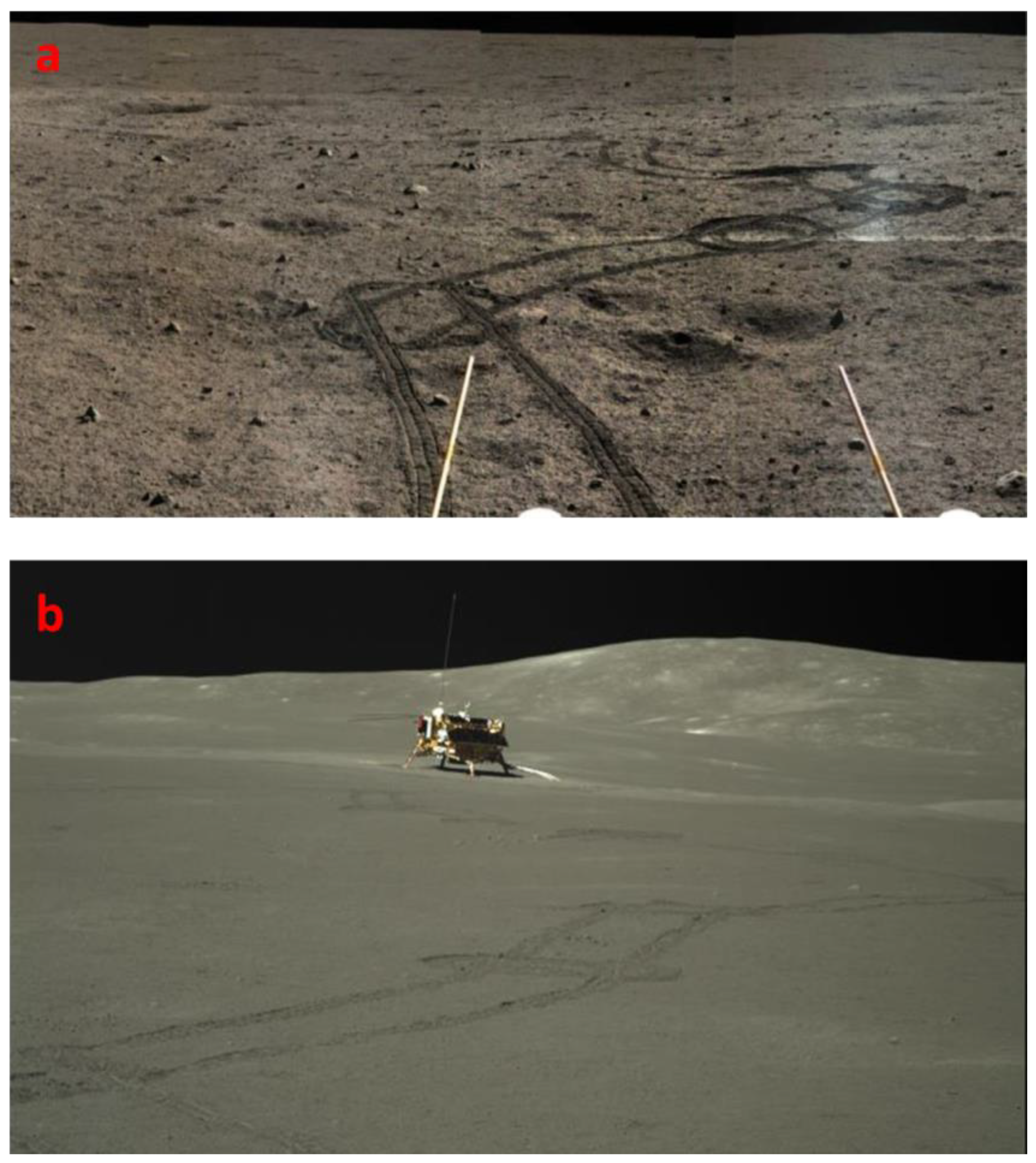
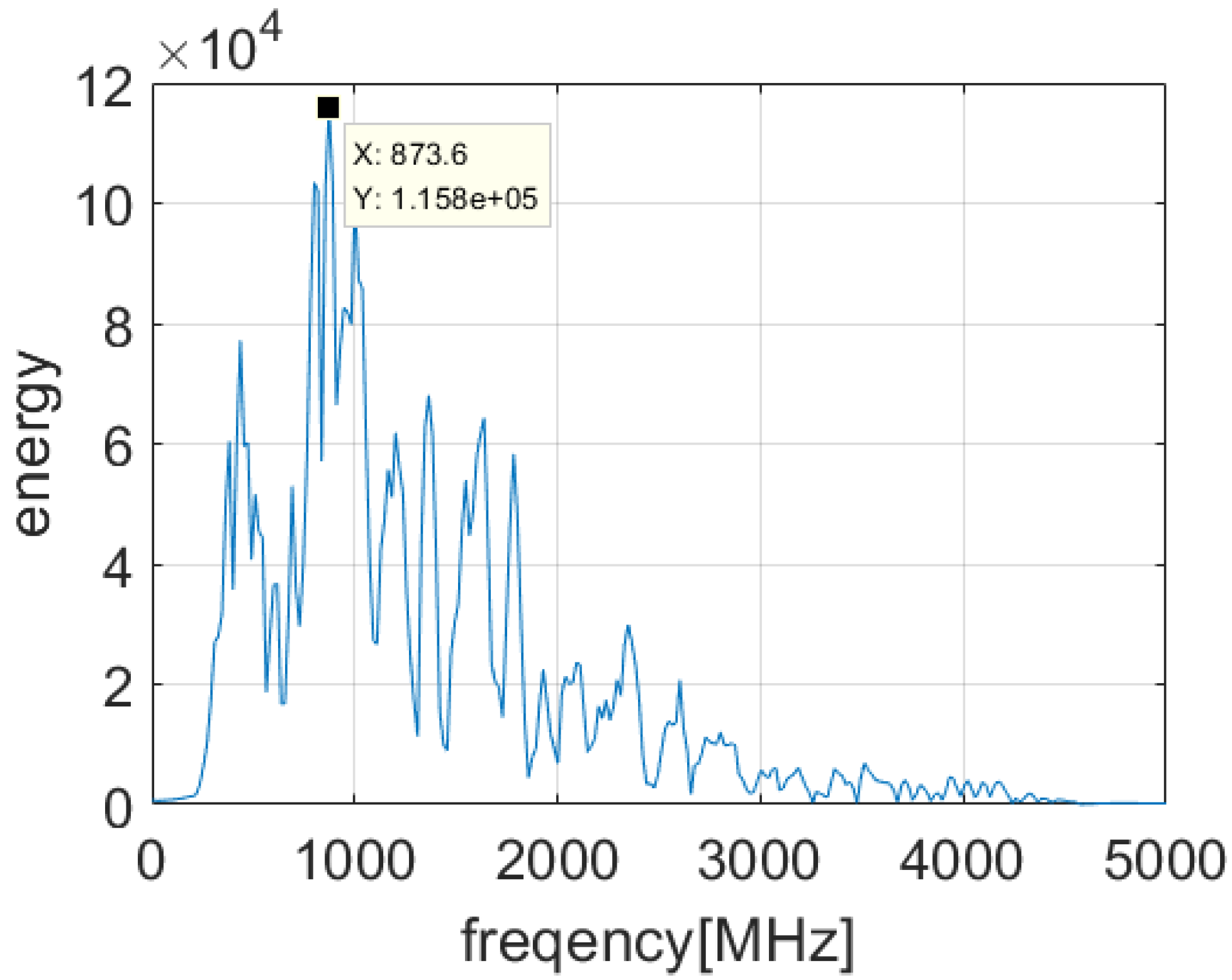
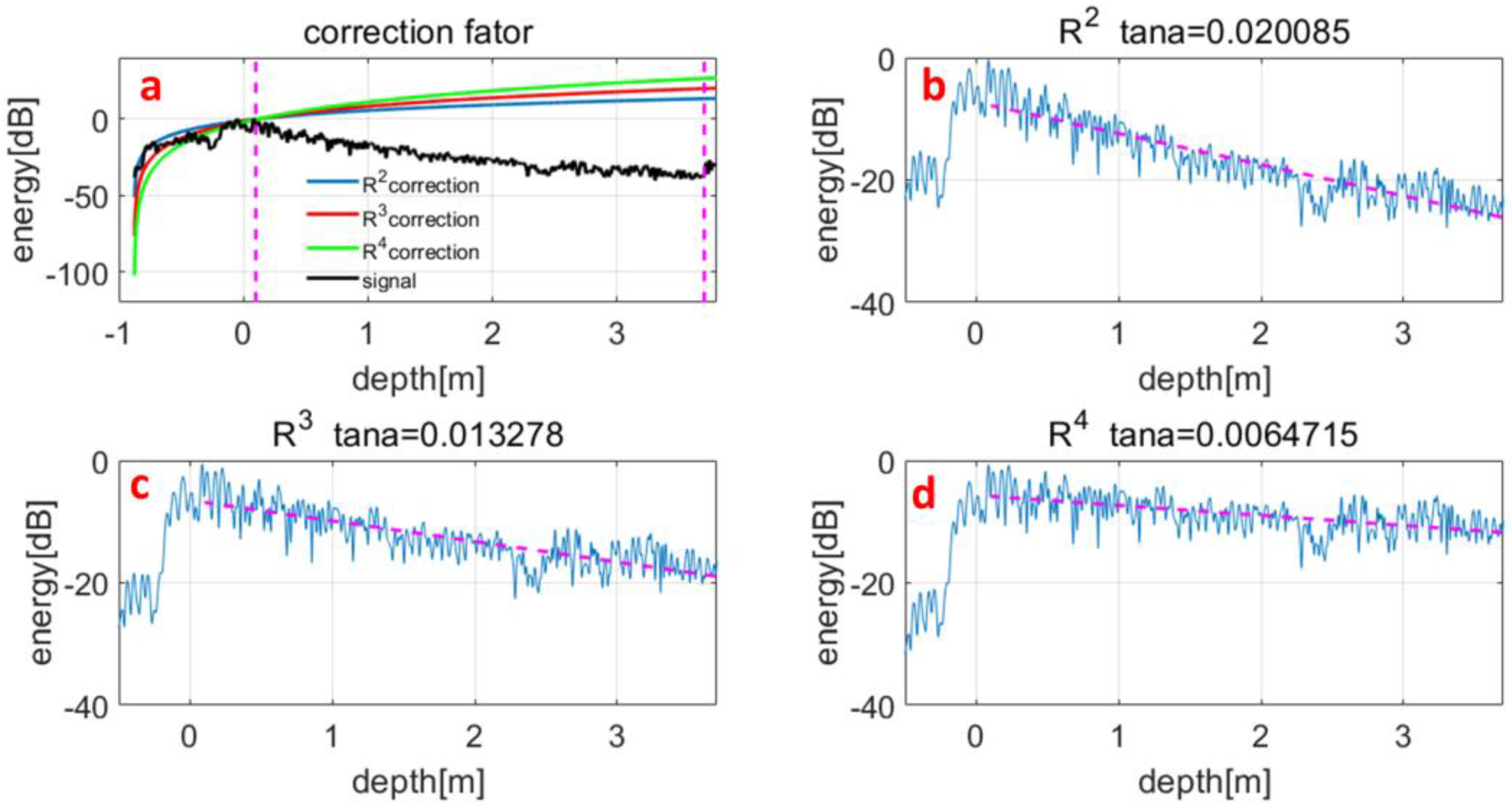
| Parameters | Performance Index |
|---|---|
| bandwidth | 1~3 GHz |
| Sample interval | 18.315 ps |
| Center frequency | 2 GHz |
| Duration time | 54.945 ns |
| Penetration depth | ≥2 m |
| Range resolution | <5 cm |
| Channel number | 132 |
Publisher’s Note: MDPI stays neutral with regard to jurisdictional claims in published maps and institutional affiliations. |
© 2022 by the authors. Licensee MDPI, Basel, Switzerland. This article is an open access article distributed under the terms and conditions of the Creative Commons Attribution (CC BY) license (https://creativecommons.org/licenses/by/4.0/).
Share and Cite
Li, Y.; Zhou, B.; Shen, S.; Lu, W.; Tang, C.; Li, S.; Su, Y.; Dai, S.; Fang, G. The Lunar Regolith Structure and Electromagnetic Properties of Chang’E-5 Landing Site. Remote Sens. 2022, 14, 4539. https://doi.org/10.3390/rs14184539
Li Y, Zhou B, Shen S, Lu W, Tang C, Li S, Su Y, Dai S, Fang G. The Lunar Regolith Structure and Electromagnetic Properties of Chang’E-5 Landing Site. Remote Sensing. 2022; 14(18):4539. https://doi.org/10.3390/rs14184539
Chicago/Turabian StyleLi, Yuxi, Bin Zhou, Shaoxiang Shen, Wei Lu, Chuanjun Tang, Shidong Li, Yan Su, Shun Dai, and Guangyou Fang. 2022. "The Lunar Regolith Structure and Electromagnetic Properties of Chang’E-5 Landing Site" Remote Sensing 14, no. 18: 4539. https://doi.org/10.3390/rs14184539
APA StyleLi, Y., Zhou, B., Shen, S., Lu, W., Tang, C., Li, S., Su, Y., Dai, S., & Fang, G. (2022). The Lunar Regolith Structure and Electromagnetic Properties of Chang’E-5 Landing Site. Remote Sensing, 14(18), 4539. https://doi.org/10.3390/rs14184539






